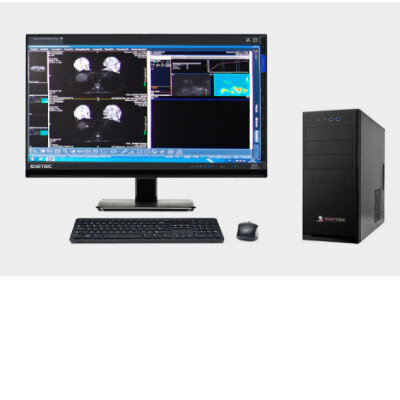Radioguided Surgery Accurately Detects and Removes Metastatic Lymph Nodes in Prostate Cancer Patients
|
By MedImaging International staff writers Posted on 06 Mar 2024 |

In patients newly diagnosed with prostate cancer, the presence and location of lymph node metastases are critical for guiding clinical decisions and planning treatment. This is because nodal involvement is associated with the recurrence of the disease. Identifying these metastases can significantly benefit patients, enabling them to receive adjuvant therapies like radiation and chemotherapy, which can enhance their outcomes. Currently, extended pelvic lymph node dissection (ePLND) is regarded as the most effective method for nodal staging. This surgical procedure aims to remove as many metastatic lymph nodes as possible from the pelvic region. While the therapeutic impact of ePLND in prostate cancer remains a subject of debate, there's evidence suggesting that removing all nodal metastases could lead to optimal control of the disease in the local and regional areas.
Now, a new study by researchers at the Radboud University Medical Centre (Nijmegen, Netherlands) has revealed that radioguided surgery is capable of detecting and extracting metastatic pelvic lymph nodes in patients newly diagnosed with prostate cancer. This technique focuses on the prostate-specific membrane antigen (PSMA), commonly overexpressed in prostate cancer cases, enhancing nodal staging and thereby aiding in forming treatment strategies for this crucial patient group. The study incorporated 20 newly diagnosed patients with prostate cancer, each with at least one lymph node suspected of metastasis based on a preoperative 18F-PSMA PET/CT scan. They underwent 111In-PSMA-radioguided surgery to remove the metastatic nodes, followed by a postoperative 18F-PSMA PET/CT scan confirming the successful excision of these lesions. This study was crucial in evaluating the safety and practicality of 111In-PSMA-radioguided surgery and its precision in identifying metastatic lymph nodes.
The study reported no adverse events linked to the 111In-PSMA-radioguided surgery. In the procedure, 29 out of 49 lesions were identified and excised, with 28 of them (97%) confirmed to be lymph node metastases. Additionally, 14 out of the 49 (29%) removed lymph nodes, which were not identified by the radioguided surgery, included two that had metastases. Although previous research has examined the feasibility of PSMA-radioguided pelvic lymph node surgery, this study is among the first to explore this method in a larger cohort of newly diagnosed patients. The results underscore the safety and feasibility of this innovative surgical technique. Importantly, each patient underwent postoperative imaging, a vital step in confirming the reliability of the outcomes.
“The current results demonstrate the great potential for radioguided surgery in prostate cancer and highlight the expanding role of molecular imaging at the operating room,” said Mark Rijpkema, PhD, principal investigator at the Radboud University Medical Centre. “Optimization of tracers and larger clinical trials may further improve surgical outcomes in the future by implementing both measurements of removed tissue, as well as real-time measurements during surgery.”
Related Links:
Radboud University Medical Centre
Latest Nuclear Medicine News
- New SPECT/CT Technique Could Change Imaging Practices and Increase Patient Access
- New Radiotheranostic System Detects and Treats Ovarian Cancer Noninvasively
- AI System Automatically and Reliably Detects Cardiac Amyloidosis Using Scintigraphy Imaging
- Early 30-Minute Dynamic FDG-PET Acquisition Could Halve Lung Scan Times
- New Method for Triggering and Imaging Seizures to Help Guide Epilepsy Surgery
- New PET Tracer Detects Inflammatory Arthritis Before Symptoms Appear
- Novel PET Tracer Enhances Lesion Detection in Medullary Thyroid Cancer
- Targeted Therapy Delivers Radiation Directly To Cells in Hard-To-Treat Cancers
- New PET Tracer Noninvasively Identifies Cancer Gene Mutation for More Precise Diagnosis
- Algorithm Predicts Prostate Cancer Recurrence in Patients Treated by Radiation Therapy
- Novel PET Imaging Tracer Noninvasively Identifies Cancer Gene Mutation for More Precise Diagnosis
- Ultrafast Laser Technology to Improve Cancer Treatment
- Low-Dose Radiation Therapy Demonstrates Potential for Treatment of Heart Failure
- New PET Radiotracer Aids Early, Noninvasive Detection of Inflammatory Bowel Disease
- Combining Amino Acid PET and MRI Imaging to Help Treat Aggressive Brain Tumors
- Medical Imaging Technique Enables Accurate Visualization of Tumor-Targeting Bacteria
Channels
Radiography
view channel
Novel Breast Imaging System Proves As Effective As Mammography
Breast cancer remains the most frequently diagnosed cancer among women. It is projected that one in eight women will be diagnosed with breast cancer during her lifetime, and one in 42 women who turn 50... Read more
AI Assistance Improves Breast-Cancer Screening by Reducing False Positives
Radiologists typically detect one case of cancer for every 200 mammograms reviewed. However, these evaluations often result in false positives, leading to unnecessary patient recalls for additional testing,... Read moreMRI
view channel
PET/MRI Improves Diagnostic Accuracy for Prostate Cancer Patients
The Prostate Imaging Reporting and Data System (PI-RADS) is a five-point scale to assess potential prostate cancer in MR images. PI-RADS category 3 which offers an unclear suggestion of clinically significant... Read more
Next Generation MR-Guided Focused Ultrasound Ushers In Future of Incisionless Neurosurgery
Essential tremor, often called familial, idiopathic, or benign tremor, leads to uncontrollable shaking that significantly affects a person’s life. When traditional medications do not alleviate symptoms,... Read more
Two-Part MRI Scan Detects Prostate Cancer More Quickly without Compromising Diagnostic Quality
Prostate cancer ranks as the most prevalent cancer among men. Over the last decade, the introduction of MRI scans has significantly transformed the diagnosis process, marking the most substantial advancement... Read moreUltrasound
view channel
Deep Learning Advances Super-Resolution Ultrasound Imaging
Ultrasound localization microscopy (ULM) is an advanced imaging technique that offers high-resolution visualization of microvascular structures. It employs microbubbles, FDA-approved contrast agents, injected... Read more
Novel Ultrasound-Launched Targeted Nanoparticle Eliminates Biofilm and Bacterial Infection
Biofilms, formed by bacteria aggregating into dense communities for protection against harsh environmental conditions, are a significant contributor to various infectious diseases. Biofilms frequently... Read moreGeneral/Advanced Imaging
view channel
New AI Method Captures Uncertainty in Medical Images
In the field of biomedicine, segmentation is the process of annotating pixels from an important structure in medical images, such as organs or cells. Artificial Intelligence (AI) models are utilized to... Read more.jpg)
CT Coronary Angiography Reduces Need for Invasive Tests to Diagnose Coronary Artery Disease
Coronary artery disease (CAD), one of the leading causes of death worldwide, involves the narrowing of coronary arteries due to atherosclerosis, resulting in insufficient blood flow to the heart muscle.... Read more
Novel Blood Test Could Reduce Need for PET Imaging of Patients with Alzheimer’s
Alzheimer's disease (AD), a condition marked by cognitive decline and the presence of beta-amyloid (Aβ) plaques and neurofibrillary tangles in the brain, poses diagnostic challenges. Amyloid positron emission... Read more.jpg)
CT-Based Deep Learning Algorithm Accurately Differentiates Benign From Malignant Vertebral Fractures
The rise in the aging population is expected to result in a corresponding increase in the prevalence of vertebral fractures which can cause back pain or neurologic compromise, leading to impaired function... Read moreImaging IT
view channel
New Google Cloud Medical Imaging Suite Makes Imaging Healthcare Data More Accessible
Medical imaging is a critical tool used to diagnose patients, and there are billions of medical images scanned globally each year. Imaging data accounts for about 90% of all healthcare data1 and, until... Read more
Global AI in Medical Diagnostics Market to Be Driven by Demand for Image Recognition in Radiology
The global artificial intelligence (AI) in medical diagnostics market is expanding with early disease detection being one of its key applications and image recognition becoming a compelling consumer proposition... Read moreIndustry News
view channel
Bayer and Google Partner on New AI Product for Radiologists
Medical imaging data comprises around 90% of all healthcare data, and it is a highly complex and rich clinical data modality and serves as a vital tool for diagnosing patients. Each year, billions of medical... Read more




















